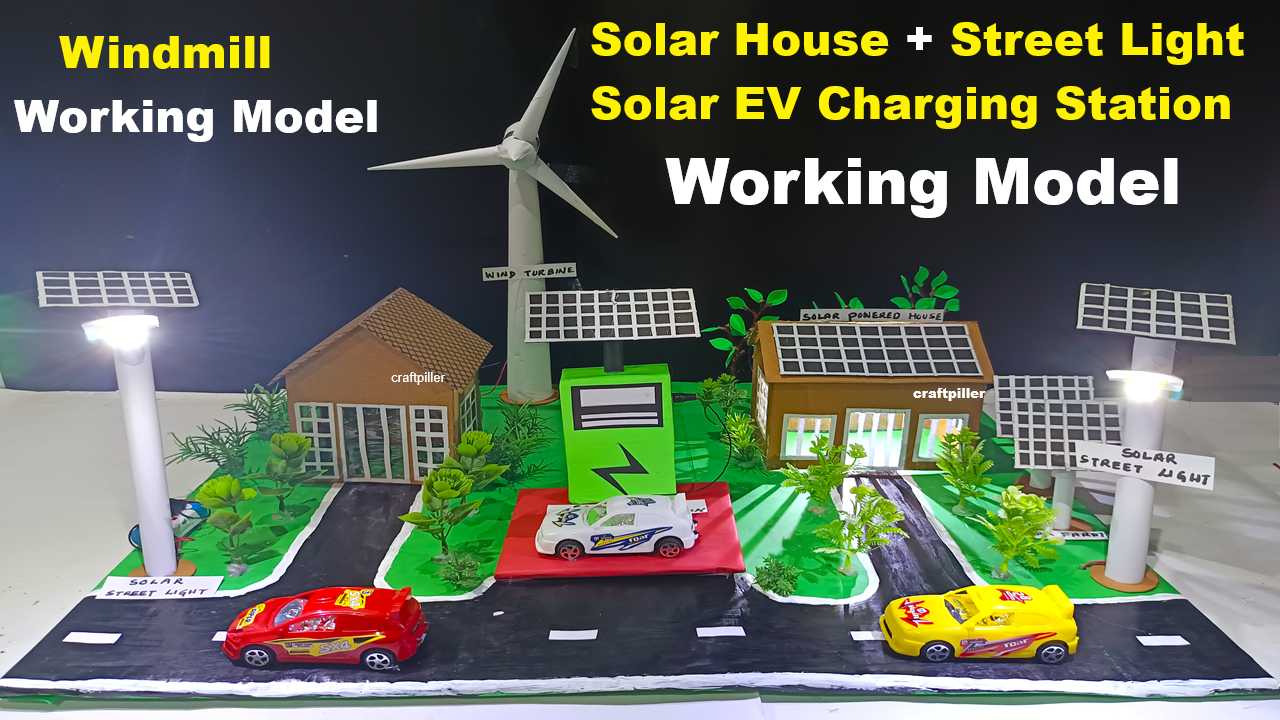Introduction
Energy is the lifeline of modern society. From switching on a light bulb to running industries, we depend on a continuous flow of electricity. But the way we produce energy today is damaging our planet. Burning fossil fuels such as coal, oil, and gas has led to global warming, air pollution, and depletion of natural resources.

This is why scientists, engineers, and students are searching for future energy solutions that are renewable, eco-friendly, and sustainable.
A future energy working model is a science project or prototype that demonstrates how energy can be generated, stored, or used in new and innovative ways. These models are highly popular in science exhibitions, Inspire Award competitions, and educational fairs because they combine creativity, engineering, and environmental awareness.
Why Future Energy Models are Important
- Rising Energy Demand – Population growth means more energy is needed every year.
- Environmental Safety – Clean and green technologies reduce carbon emissions.
- Practical Innovation – Students learn to convert classroom knowledge into real solutions.
- Awareness Creation – Exhibitions inspire society to adopt renewable energy.
- Career Opportunities – Early exposure to green technologies builds interest in engineering, environment, and research.
Examples of Future Energy Working Models
1. Hydrogen Fuel Cell Model
- Concept: Hydrogen is split from water and used as fuel, producing only water vapor as waste.
- Materials Needed: Electrolysis kit (water container, electrodes), small fuel cell, LED or motor.
- Working:
- Electrolysis splits water into hydrogen and oxygen.
- Hydrogen is fed into the fuel cell.
- Fuel cell generates electricity to light an LED or run a fan.
- Educational Value: Shows a pollution-free alternative to petrol and diesel engines.
2. Tidal and Wave Energy Model
- Concept: Energy from ocean tides and waves can be captured to produce electricity.
- Materials Needed: Small tank of water, floating objects, lever system, DC motor.
- Working:
- Moving water pushes floats up and down.
- Motion drives a motor, generating electricity.
- LED glows as proof of concept.
- Educational Value: Demonstrates a renewable source ideal for coastal regions.
3. Solar Tracking System Model
- Concept: A solar panel that follows the sun throughout the day captures more energy.
- Materials Needed: Small solar panel, servo motors, sensors, battery, LED.
- Working:
- Sensors detect sunlight direction.
- Motors adjust panel position.
- Electricity is stored and used efficiently.
- Educational Value: Teaches automation in renewable energy systems.
4. Piezoelectric Energy Floor Model
- Concept: Pressure from footsteps generates electricity.
- Materials Needed: Piezoelectric discs, wooden board, wires, battery, LED.
- Working:
- Walking or pressing the board creates vibrations.
- Discs convert pressure into electricity.
- Energy is stored in a battery and powers LEDs.
- Educational Value: Demonstrates smart city technology where stations, malls, and roads can generate power.
5. Hybrid Renewable Energy Model
- Concept: Combining solar and wind power makes energy supply reliable.
- Materials Needed: Solar panel, DC motor with blades, rechargeable battery, LED.
- Working:
- Both solar panel and wind turbine feed energy into the battery.
- Stored energy powers devices even when one source is unavailable.
- Educational Value: Shows how hybrid systems are the future of electricity grids.
6. Waste-to-Energy Plant Model
- Concept: Organic waste is converted into biogas, while plastic waste is processed into fuel.
- Materials Needed: Plastic bottle, inlet for waste, outlet tube, balloon, burner setup.
- Working:
- Waste is decomposed anaerobically to produce gas.
- Gas inflates balloon, which can fuel a small flame or run a mini burner.
- Educational Value: Demonstrates circular economy and eco-friendly waste disposal.
7. Wireless Power Transfer Model
- Concept: Future energy will also involve efficient wireless transmission.
- Materials Needed: Copper coils, power source, LED bulb.
- Working:
- Primary coil produces electromagnetic waves.
- Secondary coil receives power wirelessly.
- LED bulb lights up without direct wiring.
- Educational Value: Explains Nikola Tesla’s dream and modern wireless charging.
8. Artificial Photosynthesis Model
- Concept: Mimicking plant photosynthesis to generate fuel.
- Materials Needed: Electrolysis setup, light source, catalyst-coated electrodes.
- Working:
- Light splits water into hydrogen and oxygen.
- Hydrogen stored for fuel use.
- Oxygen released as clean byproduct.
- Educational Value: Inspires futuristic green chemistry solutions.
Future Possibilities in Real Life
- Smart Grids – AI-powered systems that manage renewable energy distribution.
- Hydrogen Cars and Planes – Fuel cells replacing petrol and diesel engines.
- Ocean Cities Powered by Waves – Floating cities using tidal energy.
- Everyday Energy Harvesting – Shoes, phones, and homes generating power from motion.
- Global Shift to Renewable Energy – Entire nations moving away from fossil fuels.
Benefits of Future Energy Models for Students
- Practical Knowledge – Students learn science by doing.
- Creativity and Innovation – Designing models improves problem-solving skills.
- Awareness of Environment – Inspires eco-friendly thinking.
- Teamwork and Presentation Skills – Exhibitions teach communication and collaboration.
- Career Inspiration – Encourages careers in engineering, green tech, and research.
Conclusion
Future energy working models are not just small science projects – they are mini-prototypes of tomorrow’s solutions. From hydrogen fuel cells to piezoelectric floors, each model shows a possible path toward a cleaner, greener, and smarter future.
Science exhibitions give students the chance to experiment, innovate, and inspire. The simple solar panel, rotating wind turbine, or bubbling biogas digester may seem small, but they represent powerful ideas that can change the world.
The energy crisis is real, but the next generation of learners has the creativity and curiosity to solve it. With future energy working models, students take the first step toward building a planet where energy is renewable, sustainable, and safe for all.
In short: The future belongs to those who create energy solutions that protect our planet and power our lives.

